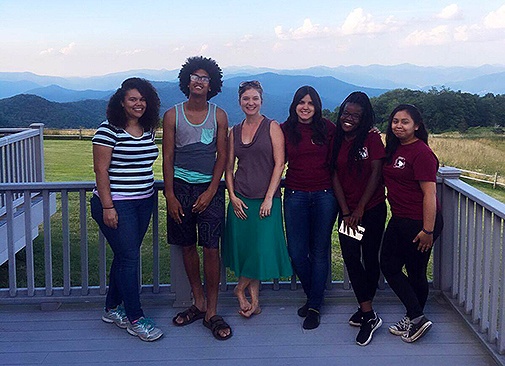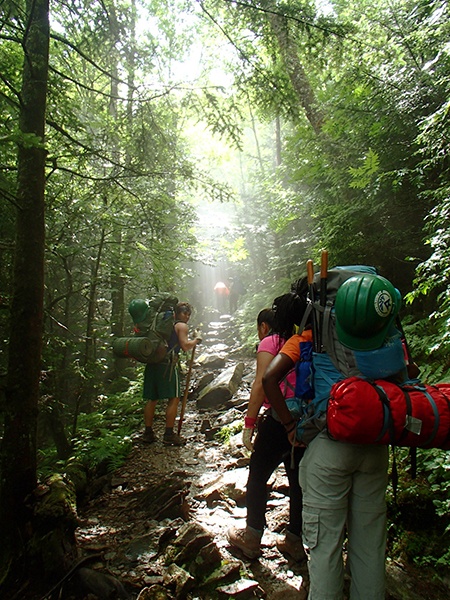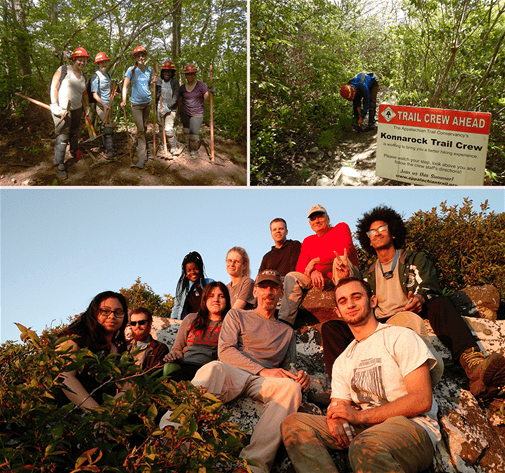Adriana Rodas was understandably nervous when she flew south from Elizabeth, New Jersey. She had just committed her summer to working on the Appalachian Trail (A.T.) — and she had never set foot on the Trail before, much less spent a night in a tent.
“Before arriving in Tennessee, I knew that the Appalachian Trail was over 2,000 miles long, but I didn’t know much else about it,” she said.
 Adriana was participating in the inaugural Conservation Leadership Corps (CLC), a program designed for young people interested in careers in conservation but who lack the experience necessary to begin working in the field. By providing this critical training opportunity and supporting the program’s alumni, the Appalachian Trail Conservancy (ATC) hopes to inspire a new generation of A.T. stewards and create a deeper pool of applicants for many of our own positions.
Adriana was participating in the inaugural Conservation Leadership Corps (CLC), a program designed for young people interested in careers in conservation but who lack the experience necessary to begin working in the field. By providing this critical training opportunity and supporting the program’s alumni, the Appalachian Trail Conservancy (ATC) hopes to inspire a new generation of A.T. stewards and create a deeper pool of applicants for many of our own positions.
2016’s CLC members spent 10 weeks in the backwoods and in classrooms learning a variety of skills essential for preserving and protecting the A.T. and its surrounding natural resources. This commitment required several members to step out of their comfort zones completely.
“My best friend [fellow CLC member Lucy Crespo] had to convince me to take this job, but from the beginning of orientation, I realized that CLC would be very different from any other job I have taken,” Adriana said. “Within just a few minutes of meeting each other, everyone was connecting like a family.”
An orientation backpacking trip helped CLC members develop skills that they would use throughout the summer, as well as for the rest of their lives.
“I was both excited and nervous packing up for our backpacking trip because it was a first for me,” said Adriana. “However, the ATC staff members who led the trip quickly made me feel confident that I could handle it. They taught us the Leave No Trace principles and how to cook and clean while in the backcountry. We even slept under tarps instead of tents, and it was very exciting — I could hear and see everything! I had never in my life felt more connected with the outdoors.”
At the end of the orientation, the CLC hiked to the summit of the iconic Max Patch, a symbolic climb that reaffirmed Adriana’s decision to take part in the program.
 “It was so foggy and cloudy that we couldn’t see any of the mountain’s famous 360 degree views,” she said. “But even the most amazing view couldn’t have made this trip any better. I was in the clouds, I had made it, and at that point I felt unstoppable.”
“It was so foggy and cloudy that we couldn’t see any of the mountain’s famous 360 degree views,” she said. “But even the most amazing view couldn’t have made this trip any better. I was in the clouds, I had made it, and at that point I felt unstoppable.”
After the orientation trip, the corps members attended the Wilderness Skills Institute, a training partnership between the ATC, the U.S. Forest Service and the Southern Appalachian Wilderness Stewards. For two weeks, the CLC received training and certifications that many conservation employers look for when hiring.
“First, we took a Wilderness First Aid class that certified us to do CPR and, if needed, to deal with certain medical situations that we may come across when in the backcountry,” said Lucy Crespo, who also hails from Elizabeth, New Jersey. “The instructors prepared me very well for what I may come across working on a crew or even on my own time, because we never really know what could happen on an otherwise normal hike.”
The CLC members also earned their certification for using crosscut saws, axes and other essential tools in a hands-on learning environment with experienced maintainers.
“Our instructors were very careful to show us how serious it is to watch for your surroundings when working with these tools, and the axe skills we learned came in handy in our next class on trail maintenance, when we learned how to use Pulaskis,” Lucy said. “In the trail maintenance class, we learned techniques to build different structures on the trails to keep them from eroding away and to make them easier for hikers to enjoy. The Wilderness Skills Institute was one of the best parts of the Conservation Leadership Corps, not only because it was fun, but because it prepared us for almost every other project that came our way.”
 One of these projects was a week-long work trip with the Konnarock Trail Crew, one of the ATC’s oldest and best-known crews. Jeremiah Roy, a corps member from New Orleans, particularly enjoyed his time working on the Trail with this highly-trained team.
One of these projects was a week-long work trip with the Konnarock Trail Crew, one of the ATC’s oldest and best-known crews. Jeremiah Roy, a corps member from New Orleans, particularly enjoyed his time working on the Trail with this highly-trained team.
“It was the CLC’s first real chance to put our new skills to the test,” he said. “Our crew was given the task of beginning a large relocation project to move the A.T. away from private land along the border of Tennessee and North Carolina. We spent the first day mapping out and walking the route of our relocated trail, an estimated mile or so to help redirect the A.T. The hike to map out the relocation wasn’t easy, as we walked through thorny vines that grabbed our ankles with every step.”
“Sounds fun, doesn’t it?” he said playfully.
Despite these difficulties, Jeremiah stated that the CLC members thrived in their roles thanks to the guidance of Konnarock Crew leaders and the support provided by the rest of the team.
“With the help of some experienced volunteers from the Carolina Mountain Club, we built 1,440 feet of new sidehill tread and cleared over 1,700 feet of corridor,” Jeremiah said. “For me, Konnarock was a mixture of pleasant camping, intense work and memories I’ll never forget.”
 After their time with Konnarock, the CLC took a break from Trail maintenance to explore other skills within the conservation field. They battled invasive plants with the ATC’s natural resources staff, educated Trail visitors alongside A.T. ridgerunners and studied snails and salamanders in the Smokies as a part of the MYLES of Science program.
After their time with Konnarock, the CLC took a break from Trail maintenance to explore other skills within the conservation field. They battled invasive plants with the ATC’s natural resources staff, educated Trail visitors alongside A.T. ridgerunners and studied snails and salamanders in the Smokies as a part of the MYLES of Science program.
“We had an incredible time learning about the rich biodiversity of the southern Appalachians,” said Natrieifia Miller, an ATC intern who joined the CLC for several weeks, including this week of conservation biology. “It was especially impactful getting to collect data that will be used in real scientific research, as several of the CLC members and I are thinking about pursuing careers in wildlife biology.”
Eventually, the corps picked up their Pulaskis once more for a week with the ATC’s most appropriately-named crew: the Smokies Wilderness Elite Appalachian Trail Crew (S.W.E.A.T.).
“While I had known since the beginning of the summer that we would be spending a week on S.W.E.A.T. Crew, I had already been a part of CLC for a few weeks before I found out what S.W.E.A.T. actually stands for,” said Niasha Hamilton, a CLC member from Niagara Falls, New York. “‘I can’t do this,’ I thought to myself. ‘I’m not an elite trail worker! I just started backpacking a couple of weeks ago!’”
But the corps was well-trained, and after a seven-mile climb into the heart of the Smoky Mountains, they spent their week clearing out debris from water bars to improve drainage, performing repairs to the footpath and Trail structures, and “brushing” the Trail — lopping the plants that persistently grow into the A.T. corridor and impede hikers.
“Hiking with tools wasn’t my ideal morning routine, but the views at Laurel Top and Bradley’s View made it all worth it,” Niasha said. “It also felt great meeting hikers and seeing how much they appreciate the Trail and the outdoors, and I realized that all the work we were doing was a vital part of their experience. So even after all the rain, the long hikes and the excessive amounts of granola, I would do it all over again.”
As the program drew to a close, the members of CLC embraced one last challenge: becoming Leave No Trace Master Educators. Throughout a five-day backpacking trip, they practiced the nuances of Leave No Trace ethics and educated Trail visitors they met along the way about how to better care for the land and its inhabitants. As a fellow student on the course, I had the joy of watching these future leaders in conservation educate others with confidence and compassion about how to care for a Trail they had come to know and love.
The transformation I witnessed since their first weeks, when some were still unsure of how to turn on their camp stove — or even what they had actually signed up for — was truly impressive.
When asked what he had learned from CLC, Jeremiah replied, “That sense that anything is possible through endurance and proper motivation, gained from climbing to the peaks of mountains that the A.T. runs through.”
Those of us who had the opportunity to work with the CLC this summer gained that sense as well, but not from climbing mountains. We gained it from seeing that the future of the Trail we hold dear is in great hands.
The Conservation Leadership Corps members were recruited through a partnership between the ATC and Groundwork USA, a national network of local organizations that offers young people in marginalized communities the opportunity to improve their environment, serve their community and explore careers in the environmental sector. For more information, visit groundworkusa.org.
The Conservation Leadership Corps was also supported by the CAN’d Aid Foundation. We dig bikes, beer, music, food and family and we’re rallying around what we love to raise money for things that matter. What started as a response to the 2013 floods in Colorado has evolved into an irreverent nonprofit that has raised $1.6 million to support its “do-goodery” efforts:
- Towns: Building strong communities
- Treads + Trails: Get outside and get after it!
- Tunes: For your eyeholes and earholes
- Love Yur Mama: Save the blue marble
For more information, contact Diana@oskarblues.com or call 970.272.5156.





